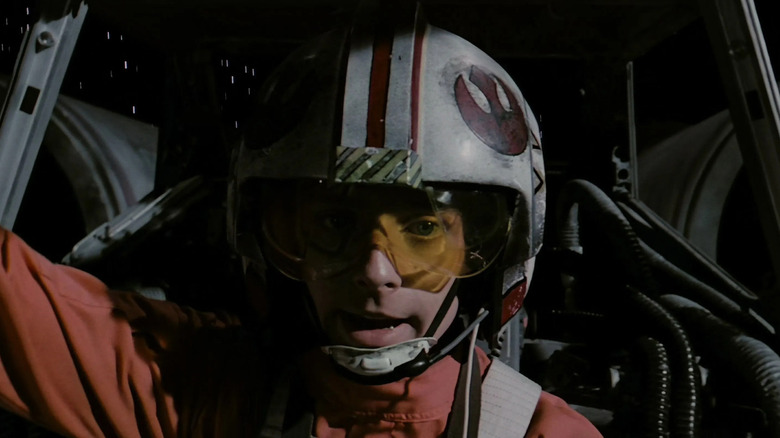Why George Lucas Didn't Kill Any Main Star Wars Characters, According To Mark Hamill
It may seem churlish to recount this, but to state it all clearly: George Lucas' 1977 blockbuster "Star Wars: Episode IV — A New Hope" centered on Luke Skywalker (Mark Hamill), a dissatisfied youth who hates his life on the backwater desert planet of Tatooine. His humdrum existence is then interrupted by the discovery of a secret holographic communiqué hidden inside a droid that his uncle recently purchased. The hologram is of Princess Leia (Carrie Fisher), the ruler of the planet Alderaan and secret leader of the Rebellion against the galaxy's tyrannical Empire. Before long, Luke finds himself joining forces with a desert-dwelling sage who goes by Ben (Alec Guinness) and leaving his home world on the spaceship of a shifty smuggler named Han Solo (Harrison Ford), all in the hope of rescuing Leia and joining the Rebellion himself.
Luke, Leia, and Han went on to form the core ensemble of the original "Star Wars" movie trilogy, with Hamill, Fisher, and Ford eventually reprising their roles in the sequel trilogy that wrapped up in 2019. Generations of "Star Wars" fans would arise before any of these characters died on-screen. In the original trilogy, of course, all three of them were still breathing by the end. Not as much can be said for old Ben (aka Obi-Wan Kenobi) or the villains Darth Vader (David Prowse) and Emperor Palpatine (Ian McDiarmid).
It's easy to see why Lucas wouldn't want to kill anyone in "A New Hope," which is itself a relatively light-hearted romp that's meant to be reminiscent of Lucas' favorite low-budget 1930s sci-fi serials and Akira Kurosawa samurai adventures (like "The Hidden Fortress"). In the two films that followed, on the other hand, the stories began to skew darker, and it felt as if lives were actually in danger. Could Luke, Leia, or Han be killed?
According to Hamill, there was never a chance of that happening. It seems that Lucas once told the actor that everyone would be safe because, well, "Star Wars" is for kids.
George Lucas felt that Star Wars was for kids
Readers should recall, of course, that Luke, Leia, and Han didn't die in the "Star Wars" movies until after Lucas had sold the franchise to Disney in 2012 and ceded all creative control to a new team of writers and producers. It was not Lucas' idea to kill his lead characters (though it remains unclear whether he had considered doing that back when he was developing the sequel trilogy himself).
Speaking to Today, however, Hamill recalled working on 1983's "Star Wars: Episode VI — Return of the Jedi" and feeling that Luke's personal character arc should lead to a more complex moral struggle. The "Star Wars" franchise, after all, takes place in a universe that's bound together by a living cosmic force called, well, the Force, which individuals can tap into, allowing them to wield powers fueled by either righteousness (the light side) or selfishness (the dark side). As Hamill saw it, Luke should've been standing on the cusp of the dark side in "Return of the Jedi," having had his hand severed by his own father, a man he'd only learned was Darth Vader. Hamill voiced his ideas to Lucas, who immediately shot him down in an exchange that the actor recounted as follows:
"When I would complain about things — in the third one, I said, 'Luke has lost his hand, he's got the black glove, shouldn't it be about Luke struggling with turning to the dark side?' George said, 'Mark, it's for children.' And that's why he would never consider killing any of the main characters. In the new ones, they pop us off one at a time."
Of course, Lucas did eventually start killing characters by the time he made 2005's "Star Wars: Episode III — Revenge of the Sith," which saw the heroic Senator Padmé Amidala (Natalie Portman) — Luke and Leia's mother — die in childbirth. But that film, a prequel, was a tragedy about the initial moral fall of Darth Vader and his evolution from the noble Jedi Anakin Skywalker (Hayden Christensen) to a wicked, murderous Sith warrior. In a story like that, perhaps it was appropriate for one of the (newer) main characters to die.

